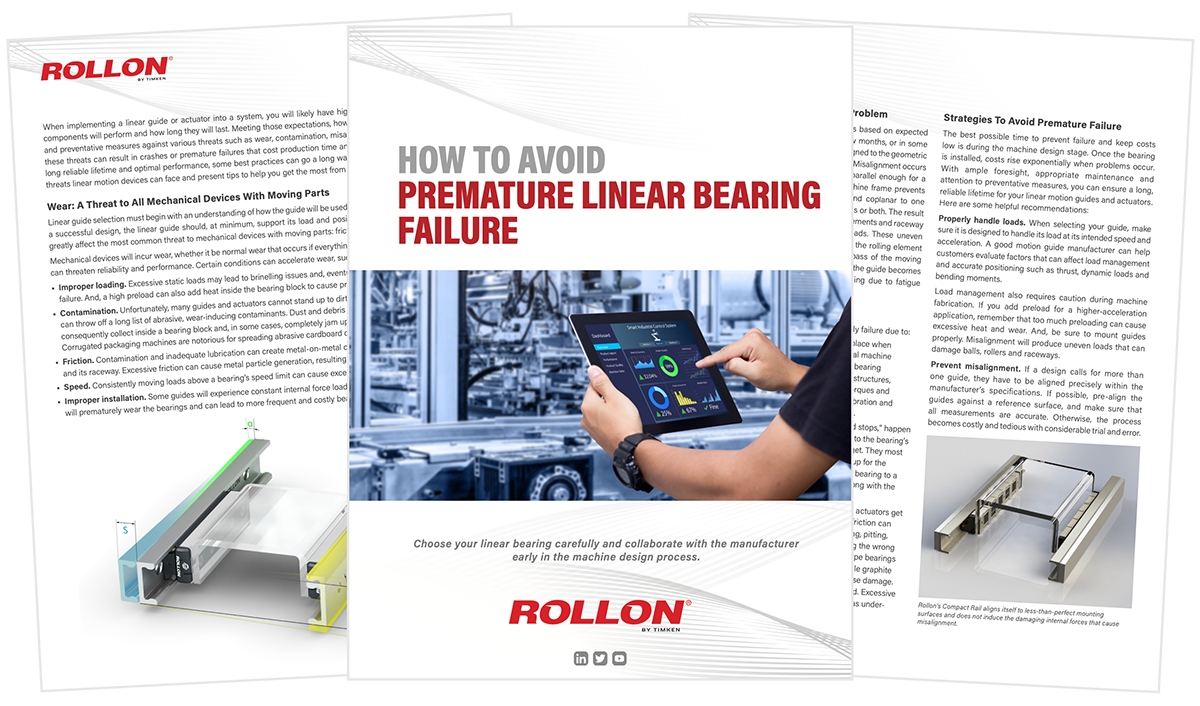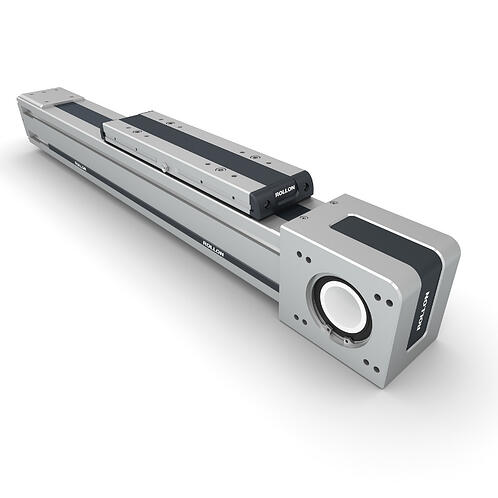
Linear Actuators, Linear Guides
How To Avoid Premature Linear Bearing Failure
When implementing a linear guide or actuator into a system, you will likely have high expectations for how well the linear components will perform and how long they will last. Meeting those expectations, however, requires careful product selection and preventative measures against various threats...

Linear Actuators
PODCAST: Linear Electromechancial Actuators and Preplanning
Many different linear actuators that people in industrial automation are familiar with provide straight-line motion. Rollon’s Bob Ward, Regional Manager, and Christopher Hirsch, Actuator Product Manager, spoke about the linear electromechanical actuator gaining popularity.
"We're definitely in a...

Linear Actuators
Explore our Belt Driven Actuator for Dirty Environments
When you need a belt-driven actuator for automated linear motion, there’s a good chance you intend to use it in an aggressive working environment. If that’s the case, keeping chips and other debris out of your actuator will be your first concern as you specify your unit. After all, particle...
_Images%20articles/CARTESIAN%20SYSTEM%20OR%20ANTHROPOMORPHIC%20ROBOT/Multi_axis_rollon_eng.jpg)
Linear Actuators, Multi-Axis Systems, Robotics
Cartesian System or Articulated robot?
Industrial automation is no longer either an opinion or an option. It’s a fact. As a concrete part of business, it increases complexity for industrial designers and planners commissioned to design new solutions that can improve processes and make them more productive, efficient, and effective.
_Images%20articles/LINEAR%20ACTUATOR_%20WHAT%20THEY%20ARE%20AND%20HOW%20TO%20CHOOSE%20THEM/LINEAR_ACTUATOR__WHAT_THEY_ARE_AND_HOW_TO_CHOOSE_THEM_rollon.webp)
Linear Actuators
Linear Actuators: what they are and how to choose them
A linear actuator is a self-supporting structural system capable of transforming a circular motion generated by a motor into a linear motion along an axis. Helping to produce movements such as the pushing, pulling, raising, lowering or inclination of a load.
The most common use of actuators...
_Images%20articles/Adding%20a%20Seventh%20Axis%20to%20Your%20Robotic%20System%20Brings%20Many%20Benefits/rollon_7TH-AXIS_adding_seventh_axis_robot_eng.jpeg)
Linear Actuators, Multi-Axis Systems, Robotics
Adding a Seventh Axis to Your Robotic System Brings Many Benefits
There’s no disputing that automation technology has changed the face of industrial operations. Nowhere is this more evident than spot welding, assembly and material handling where six-axis articulated arm robots perform complex tasks with high precision.
While these and other industries rely on...
_Images%20articles/SPECIFYING%20ACTUATORS%20FOR%20HEAVYDUTY%20PACKAGING%20APPLICATIONS/SPECIFYING_ACTUATORS_FOR_HEAVYDUTY_PACKAGING_APPLICATIONS_rollon.jpeg)
Linear Actuators
Specifying actuators for heavyduty packaging applications
The task of selecting, sizing and applying linear actuators involves many variables, from stroke length and duty cycle to precision and accuracy requirements. Ultimately, matching the right actuator to the intended application requires a close look at all of the specifications involved and then...
_Images%20articles/Adding%20a%20Seventh%20Axis%20to%20Your%20Robotic%20System%20Brings%20Many%20Benefits/rollon_7TH-AXIS_seventh_axis_robot_eng.jpeg)
Linear Actuators
Actuator Requirements For 7th Axis Robotics
Adding a seventh axis to your six-axis robotic system can be beneficial in a number of ways. Your work envelope is expanded, allowing the use of smaller, less-expensive robots.
Parts can also be transferred to multiple workstations at greater distances, and more machines and processes are able to...
_Images%20articles/Adding%20a%20Seventh%20Axis%20to%20Your%20Robotic%20System%20Brings%20Many%20Benefits/rollon_7TH-AXIS_seventh_axis_robot_eng.jpeg)
Linear Actuators, Multi-Axis Systems
Rollon Seventh-Axis Series Actuators Give Robotic Arms Strength and Flexibility
Rollon Corporation now manufactures linear actuators capable of providing a seventh axis of motion to anthropomorphic six-axis robotic arms with a curb weight of up to five-thousand pounds! Seventh-Axis systems — part of our Actuator Line Series — offer a host of customizable features to meet the...